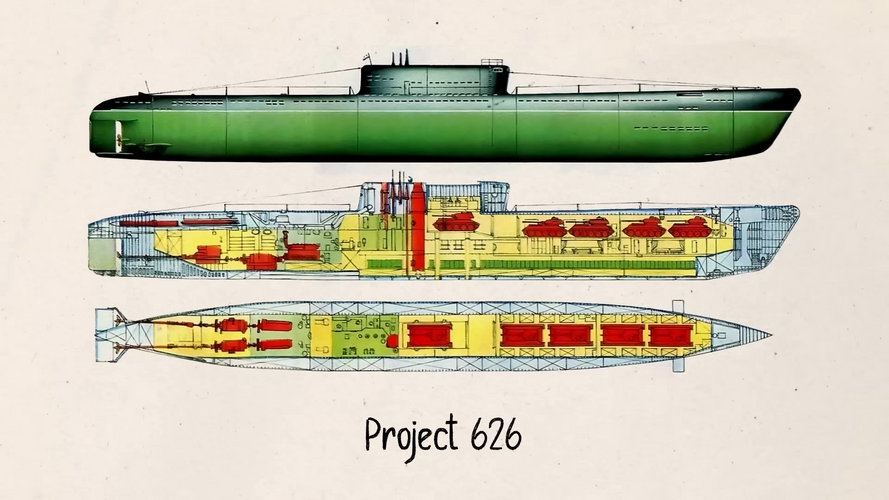In August 1965 TsKB-16, later Rubin, was directed to respond to the Tactical-Technical Elements (TTE) requirement for a large diesel-electric submarine LST designated Project 748. The design bureau, realizing the limitations of conventional propulsion for this submarine's missions, additionally initiated nuclear-propelled variants.
Six variants of Project 748 were developed with surface displacements from 8,000 to 11,000 tons. Most variants had three separate, cylindrical pressure hulls side-by-side, encased in a single outer hull. The first variant met the basic TTE; the second variant carried a larger number of PT-76 amphibious tanks; the third variant had VAU-6 auxiliary nuclear power plants; the fourth variant had two OK-300 reactor plants generating 30,000 horsepower; the fifth variant had the VAU-6 system with a single pressure hull; and in the sixth variant the OK-300 plant was replaced by four VAU-6 units.
This large submarine could carry up to 20 amphibious tanks and BTR-60P armored personnel carriers, and up to 470 troops. In addition to a torpedo armament of four bow 21-inch torpedo tubes with 18 to 20 torpedoes, the submarine was to be fitted with anti-aircraft guns and surface-to-air missiles. And, of course, the submarine could serve as a minelayer.
TsKB-16 recommended proceeding with the fourth (nuclear-propelled) variant. Still, construction was not initiated because the Navy, Ministry of Shipbuilding Industry, and General Staff of the Armed Forces ordered a review of the features of Projects 632, 648, 664, and 748 in an effort to develop a "ubiquitous" or all-capable nuclear submarine. TsKB-16 (now named Volna) was directed to develop a preliminary design for the submarine designated Project 717.
Sources:
"The First Soviet Giants" by Norman Polmar published in Undersea Warfare magazine:
http://www.navy.mil/navydata/cno/n87/usw/issue_13/soviets_giants.html
Cold War Submarines: The Design and Construction of U.S. and Soviet Submarines by Norman Polmar and Kenneth J Moore, Brassy's, Inc., 2004
Six variants of Project 748 were developed with surface displacements from 8,000 to 11,000 tons. Most variants had three separate, cylindrical pressure hulls side-by-side, encased in a single outer hull. The first variant met the basic TTE; the second variant carried a larger number of PT-76 amphibious tanks; the third variant had VAU-6 auxiliary nuclear power plants; the fourth variant had two OK-300 reactor plants generating 30,000 horsepower; the fifth variant had the VAU-6 system with a single pressure hull; and in the sixth variant the OK-300 plant was replaced by four VAU-6 units.
This large submarine could carry up to 20 amphibious tanks and BTR-60P armored personnel carriers, and up to 470 troops. In addition to a torpedo armament of four bow 21-inch torpedo tubes with 18 to 20 torpedoes, the submarine was to be fitted with anti-aircraft guns and surface-to-air missiles. And, of course, the submarine could serve as a minelayer.
TsKB-16 recommended proceeding with the fourth (nuclear-propelled) variant. Still, construction was not initiated because the Navy, Ministry of Shipbuilding Industry, and General Staff of the Armed Forces ordered a review of the features of Projects 632, 648, 664, and 748 in an effort to develop a "ubiquitous" or all-capable nuclear submarine. TsKB-16 (now named Volna) was directed to develop a preliminary design for the submarine designated Project 717.
Sources:
"The First Soviet Giants" by Norman Polmar published in Undersea Warfare magazine:
http://www.navy.mil/navydata/cno/n87/usw/issue_13/soviets_giants.html
Cold War Submarines: The Design and Construction of U.S. and Soviet Submarines by Norman Polmar and Kenneth J Moore, Brassy's, Inc., 2004












